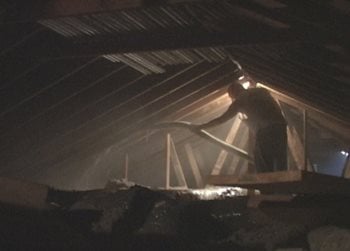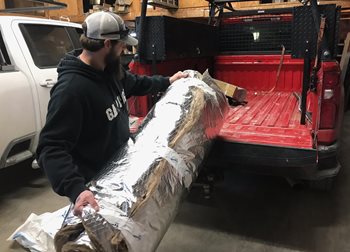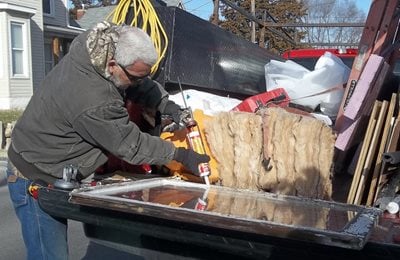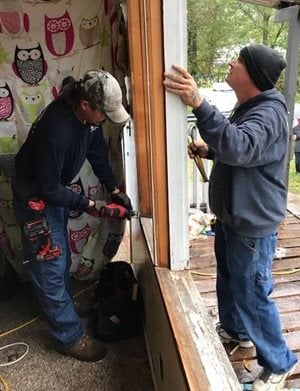Lauren Blackstun used to feel the chill of winter in her living room. But her home is now energy efficient, thanks to Missouri's North East Community Action Corporation (NECAC).
 "They've been very helpful," says Blackstun, who has lower electric bills and lower gas bills after NECAC caulked her windows and doors, replaced exterior doors and lighting, wrapped the hot water heater, added insulation and replaced windows.
"They've been very helpful," says Blackstun, who has lower electric bills and lower gas bills after NECAC caulked her windows and doors, replaced exterior doors and lighting, wrapped the hot water heater, added insulation and replaced windows.
NECAC will weatherize more homes than usual in the years ahead thanks to a grant that allowed the organization to double its capacity. NECAC also leased an additional site and added crew members. Over three years, NECAC expects to upgrade up to 1,000 homes.
"We typically service about 85 to 100 homes a year," says Britany Kidd, procedural director for NECAC's weatherization program. "This year, we will probably triple that amount."
NECAC's weatherization program. "This year, we will probably triple that amount."
To weatherize a home, staff analyze space for leaking air. They then seal the leaks, which may involve caulk, insulation or even new windows and doors. They also look for ways to save energy by replacing light fixtures or bulbs or improving or replacing HVAC systems.
"We go out there and do what we do best to seal up a home and make it energy efficient," says Kidd. NECAC's Weatherization Center provides outreach to 12 counties. It's especially important for low-income clients who are on a strict budget. "Our goal is to lower utility costs and to provide energy-efficient measures to make it comfortable for the client."
Creating jobs
The Weatherization Program is doing more than saving energy and money, says Carla Potts, deputy director for Housing Development. It's also creating jobs. Last year, as the organization recruited employees, NECAC started a weatherization apprenticeship program. The first graduates received their certificates this summer.
 "We were struggling to find employees and we said, 'We've got to do something,'" Potts says. They talked to the work investment board, and then the state of Missouri, before becoming a registered apprenticeship program. "We created career pathways in both green energy and weatherization," Potts says.
"We were struggling to find employees and we said, 'We've got to do something,'" Potts says. They talked to the work investment board, and then the state of Missouri, before becoming a registered apprenticeship program. "We created career pathways in both green energy and weatherization," Potts says.
Clintan Caldwell started with the program last year and is currently working on his second apprenticeship. "I strongly believe this will be my career path going forward," he says. "I want to continue working for NECAC while continually learning new skills so I can better serve our clients and possibly help train others who want to follow the same path."
The program includes 144 hours of classroom time and 2,000 hours of on-the-job training over the course of a year. The participants, more than a dozen so far, are local to the communities NECAC serves. Potts says she recruits at vocational schools and more. She has presented webinars to help other community development organizations learn about the program.
"Weatherization is the first green energy in my opinion," Potts explains. "Our whole job is to help homeowners or renters have a more energy-efficient home. To me, that says green."
Her advice for NeighborWorks organizations that have weatherization programs and want to start an apprenticeship program?
- "Don't think this is going to take forever or be super hard."
- "It is worth it for the people who work for you and for the clients we seek to serve. It's worth it to create this career."
- "Don't think it will take more time than you have or that the training is more than you're doing – it's what you are doing."
Stabilizing communities
Clare Rosenberger, director of Real Estate Programs for NeighborWorks America, says weather-proofing a home – and preparing for a change in weather – is important every year, all year.
Rosenberger points out that weatherization helps people create efficient, healthier homes – and helps
 people stay in those homes. "It helps people stay in the community," she adds. "It's part of our community stabilization services. People trust these organizations. They may have helped them get their home; they may have helped them refinance it. They can help with this, too."
people stay in those homes. "It helps people stay in the community," she adds. "It's part of our community stabilization services. People trust these organizations. They may have helped them get their home; they may have helped them refinance it. They can help with this, too."October, National Energy Awareness Month, is a great time of year to assess your home, Rosenberger says. "In many parts of the country, people are feeling that chill in the air and our organizations are able to deliver great resources for the local community." Rosenberger says that just as network organizations are able to help residents find resources for rent and mortgage relief, those that specialize in weatherization know where to access additional funds for that purpose.

